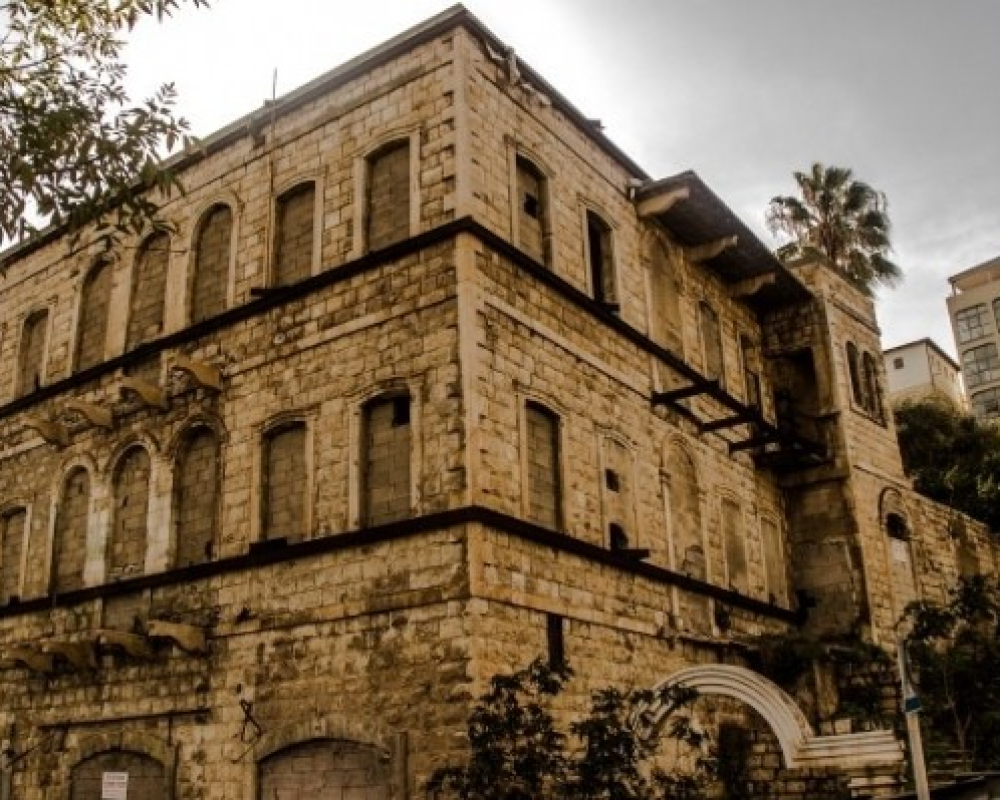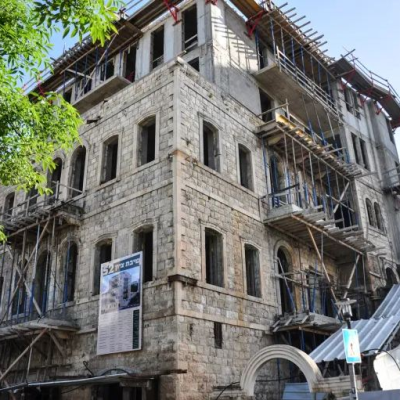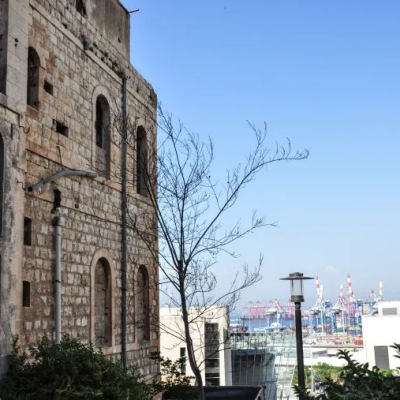
Haifa /PNN /
The city of Haifa sits like a cascading waterfall on the lush green slopes of Mount Carmel, overlooking the bright blue Mediterranean Sea.
But behind the skyscrapers and concrete buildings of Haifa, a small cluster of Palestinian homes, built with sandstone before 1948, tells a different story. Al Jazeera English correspondent Zeina Tahhan visited the area to tell the alternative narrative.
Haifa fell under the control of Zionist militias in April 1948, three weeks before the Nakba and Israel's declaration of independence on May 14th, marking the end of the British Mandate in Palestine on May 15th.
By that time, the Zionist forces had forced more than 95% of Haifa's population to leave and abandon their land. Out of 75,000 Palestinians in the city, only about 4,000 remained. The rest became refugees, particularly in neighboring Lebanon and Syria, and were prevented from returning to this day.
During the Nakba and the decades that followed, the Zionist and Israeli forces destroyed most of the Palestinian neighborhoods and buildings in Haifa, reducing them to rubble.
The historic center of the ancient city was almost completely destroyed, and the area has now been transformed into a modern square of Israeli government and commercial buildings, with a large parking lot.
For example, a 29-story building housing government offices was constructed in 1999 on the ruins of "Saraya Haifa," a mid-18th-century administrative building and local government headquarters that was demolished in 1949. It was one of the nine Saraya buildings in historic Palestine, dating back to the Ottoman era.
Urban planner Oroub Suwitat said, "They built government buildings on the ruins of Palestinian Arab buildings, buildings that were destroyed and erased during the Nakba."
Suwitat, who holds a Ph.D. in urban and architectural planning and works to prevent further demolitions, added, "Today, there is no trace of this major crime."
"11 buildings worth $20 million"
According to Haifa historian Johnny Mansour, "Only 20% of Haifa's original homes are still standing." The ownership of the surviving Palestinian buildings, which escaped the Nakba, was transferred to the state under the Israeli Absentee Property Law.

This was not limited to Haifa; Israel seized all Palestinian properties left by their owners, either as refugees or internally displaced persons.
Suwitat stated, "In historic cities like Haifa, Jaffa, and Acre, around 70,000 historic buildings were confiscated after 1948." She explained that out of the buildings that existed in 1948, only 4,800 remain today.
The urban expert added, "All the buildings are in the hands of the state. The rest were demolished or sold to private real estate companies. In Jaffa, there are only about 1,200 buildings left, 600 in Haifa, 600 in Acre, and about 350 in Nazareth."
Nowadays, Israelis live in some of the buildings that once housed the Palestinian residents of old Haifa, with some converted into Israeli art galleries and bars.
Since 2000, the Israeli government has started selling the remaining Palestinian buildings to public and private real estate companies, either demolishing them to build modern residential or commercial projects in their place or renovating them and selling them as luxury properties to the Israeli market.
Suwitat said, "They are turning the ruins of the Nakba into economic gems for the Israeli market," noting that "the development process aims to attract middle-class and upper-class Jews and expel Palestinian Arabs."
And a member of the Committee for the Preservation of Historical Buildings in Haifa Municipality added, "Both Israeli laws and city planning have worked together to seize the properties and lands of Palestinian refugees, erase, destroy, distort, and transform the Palestinian Arab identity and characteristics in Haifa into the private sector."
Nowhere is the story of looting and erasure more evident than in Wadi Salib, a Palestinian neighborhood that was once thriving and seems frozen in time since the Nakba, as the stone houses stand as silent witnesses, overlooking the Mediterranean Sea at a distance of about one kilometer.
Most of the neighborhood was demolished in 1949, and Israel brought Jews from North African countries to exploit the remaining Palestinian houses and buildings, where they lived for 10 years before protests erupted against the difficult and racist living conditions, leading to the relocation of residents to another place.
Since then, most of the Palestinian buildings have been closed off with concrete blocks or covered with metal sheets.
In previous decades, the remaining parts of Wadi Salib were sold by the Israeli government to private and public real estate companies.
Sweitat said, "They offer very large tenders that only big companies can enter, and Palestinians cannot afford the cost. For example, 11 historical buildings were sold 10 years ago for one million dollars. Today, they want to sell the same 11 buildings for 20 million dollars."
"How did this happen to us?"
Abdul Abdi, an 81-year-old Palestinian visual artist, was expelled from Wadi Salib and Palestine as a whole with his mother and four siblings in 1948.
His father managed to stay in Haifa, and after three years of moving between refugee camps in Lebanon and Syria, Abdi and his mother and three siblings were among a few Palestinians allowed to return to their city in a family reunification process.
However, his older sister, Latifa, was unable to return and remained in the Yarmouk refugee camp in Syria until her death three years ago.
Abdi says to Al Jazeera, "We tasted displacement and exile in Lebanon and Syria," and he added from his private studio in Haifa, "Our family was separated like many Palestinian families from Haifa at that time."
From 1947 to 1949, Zionist forces expelled at least 75% of the Palestinian population, destroyed 530 Palestinian villages, forced people out of major cities, and killed around 15,000 Palestinians in a series of genocidal crimes, including numerous massacres.

Today, Palestinian refugees represent the longest-standing unresolved refugee issue in the world. Approximately 6 million registered refugees live in at least 58 camps in Palestine and neighboring countries.
The first refugee camp Abdi and his family arrived at was the Mia Mia camp in Lebanon, he says while surrounded by dozens of his paintings depicting the Nakba and Arab neighborhoods in Haifa, based on his childhood memories.
Abdi, who incorporated canvas from tents into his artwork, adds, "I remember that the partitions between families were made of tent canvas. When I touch and smell this fabric now, it takes me back to my childhood, and this memory has stayed with me throughout my life."
He continues, "I also remember how my mother used to make shoes for us from leather bags."
Many Palestinians who remained in Haifa after the Nakba, including Abdi's father, were gathered and forced to live in the Wadi al-Nisnas neighborhood. They were not allowed to reclaim their properties in other parts of the city under Israeli military rule and faced continuous curfews.
Abdi's father moved to his aunt's house in Wadi al-Nisnas, a few kilometers away from their destroyed home in Wadi Salih. They shared a 4-bedroom house with another displaced Palestinian family from Haifa.
When the rest of Abdi's family returned in 1951, all six of them lived in a single bedroom for 10 years before they were able to move.
Despite more than seven decades passing, Abdi says that the loss and displacement caused by the Nakba are still incredibly difficult. He added, "I often go back to Wadi Salih. The area is not far from me. I remember my childhood and my tragedy."
He concluded, "When I see it, I always feel something more than just sadness, but a recurring question of how? How did this happen to us? These empty and destroyed buildings, where are their owners? How were we expelled?"
Source: Al Jazeera